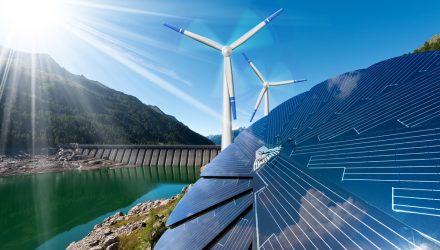The ALPS Clean Energy ETF (ACES) is one of this year’s best-performing industry ETFs and a slew of favorable data points from the solar energy space are helping the ACES cause. Fortunately, there are positive long-term implications that can potentially contribute to more ACES bullishness.
Emerging markets are also taking a cleaner approach as they try to cut down on pollution. For example, China, the world’s second-largest economy, suffers from heavy pollution after it quickly industrialized its economy, but it has also heavily adapted to solar as a means to combat the rising pollution and shift away from dirty coal.
“Solar tracker shipments reached new record levels in 2019 with shipments exceeding 31GW globally, an increase of 55 percent year-on-year,” according to IHS Markit. “Exceptional demand in the United States, as well as multiple 1 GW plus markets in Brazil, Mexico, Chile, Spain, and Australia, helped propel shipments to new heights. Furthermore, for many suppliers active in the United States the stepdown in the investment tax credit (ITC) and the willingness of developers to safe harbor for projects yet to be built has meant that 2020 started very strongly for numerous suppliers.”
ACES High
ACES follows the CIBC Atlas Clean Energy Index. That benchmark is comprised of U.S. and Canada-based companies that primarily operate in the clean energy sector. Constituents are companies focused on renewables and other clean technologies that enable the evolution of a more sustainable energy sector.
Not only is clean energy consumption increasing, but costs are also decreasing, which in turn bolsters adoption. Additionally, coal production is slumping, adding to the virtuous cycle for alternative energy ETFs. Declining solar costs are expected to lure more corporate and residential customers.
“Overall, solar tracker prices are expected to continue to decline on a dollar cost per watt basis as the energy production per module continues to increase. The major benefit to developers and EPC’s will be the improved energy yield of using higher powered bifacial modules along with solar trackers which is expected to greatly improve the levelized cost of electricity for utility-scale projects and make solar more cost-competitive with other forms of energy generation,” notes IHS Markit.
While solar is shining, the sun can’t have all the fun—alternative sources of energy like wind and lithium funds could also experience more growth
Other alternative energy ETFs include the First Trust Global Wind Energy ETF (FAN) and the SPDR Kensho Clean Power ETF (CNRG).
For more on cornerstone strategies, visit our ETF Building Blocks Channel.
The opinions and forecasts expressed herein are solely those of Tom Lydon, and may not actually come to pass. Information on this site should not be used or construed as an offer to sell, a solicitation of an offer to buy, or a recommendation for any product.








